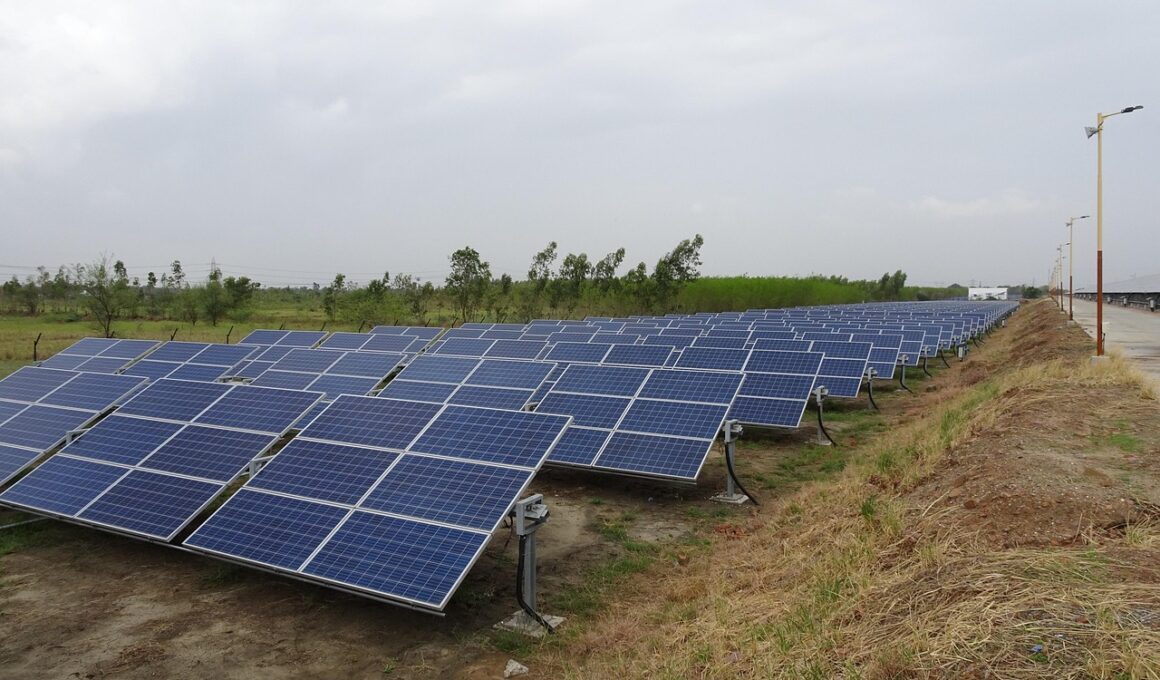Innovative Financing Mechanisms for Sustainable Infrastructure Development
Sustainable infrastructure finance incorporates innovative financing mechanisms that enable projects to meet environmental and social standards. These mechanisms often seek to address common challenges such as funding gaps and investor hesitance. One notable approach is the use of green bonds, which attract investments dedicated to environmental projects. Green bonds not only provide governments and corporations access to capital for sustainable initiatives but also appeal to eco-conscious investors. They can fund renewable energy, water management, and sustainable transportation systems. Another mechanism is the public-private partnership (PPP), which allows both sectors to share risks and rewards. In doing so, PPPs create opportunities for cost-sharing and efficiency. Mechanisms such as sustainability-linked loans tie interest rates to performance metrics, thereby incentivizing companies to improve their sustainability practices. Further, blended finance creatively combines public and private funding sources to enhance investment in underserved markets. By incorporating innovative financing approaches, stakeholders can advance sustainable infrastructure development, ensuring positive socio-economic impacts while mitigating environmental harm. Policymakers and financial institutions must collaborate to expand the potential for these mechanisms globally.
Benefits of Sustainable Infrastructure Finance
Sustainable infrastructure finance offers numerous benefits that extend beyond merely funding projects. The long-term economic benefits can enhance community resilience and promote job creation through the construction and maintenance of sustainable facilities. By prioritizing renewable energy and eco-friendly designs in infrastructure development, communities often experience significant reductions in energy costs and greenhouse gas emissions. Moreover, these projects may foster social equity, as they often aim to improve access to essential services such as transportation, clean water, and affordable housing for marginalized communities. Engaging local stakeholders in the decision-making process can strengthen community ownership and acceptance of projects, leading to enhanced outcomes. Investors, on the other hand, can benefit from risk mitigation through diversified portfolios that include sustainable projects. Meeting consumer demand for environmentally responsible solutions also attracts a broader investor base to these initiatives. Furthermore, sustainable infrastructure investments can stimulate technological innovations and promote regional economic growth. Therefore, embracing sustainable finance mechanisms can create job opportunities and strengthen economies, leading to thriving communities built on principles of sustainability and resilience, ultimately contributing to global targets such as Sustainable Development Goals.
To successfully implement sustainable infrastructure projects, governments must establish supportive policies and frameworks. Clear regulatory standards and incentives help create a conducive environment for sustainable financing initiatives. Initiatives like tax credits or grants can increase market attractiveness and encourage investor participation. Additionally, transparency in how funds are allocated and monitored builds investor confidence and drives accountability. Reports on the impact of sustainable infrastructure projects are crucial for stakeholders involved in financing and development. Establishing metrics and benchmarks for success is essential for evaluating the sustainability of infrastructure initiatives. Integrating climate risk assessments into infrastructure planning can also enhance resilience and address potential vulnerabilities. International cooperation and knowledge sharing between countries can lead to successful implementation of innovative financing mechanisms. Best practices exchanged globally can set precedents and improve local governance regarding sustainable development. Collaborative platforms like the Green Climate Fund promote innovative financing solutions that consider socio-economic factors in developing nations. Leveraging these tools enables countries to adapt to climate change while enhancing infrastructure quality. Financing is not merely a challenge but an opportunity to build the resilient communities of tomorrow while addressing urgent global needs.
Challenges and Solutions in Financing
Despite the numerous advantages of sustainable infrastructure finance, several challenges persist that can hinder progress. One key issue is the inherent mismatch between the long-term nature of infrastructure projects and the short-term investment horizon of many investors. This creates reluctance to commit funds to projects with prolonged payoff periods. To address this, innovative solutions like blended finance can align interests by combining funds from various sources, thus reducing risks for private investors. Furthermore, the lack of comprehensive data on sustainable project performance often leads to perceived uncertainties deterring investment. Developing robust frameworks to measure and communicate the environmental and social impact of investments can help enhance transparency and build trust in the market. Another challenge is the existing regulatory barriers that stifle the scalability of sustainable finance initiatives. Policymakers need to reevaluate current regulations to better support innovative financing mechanisms while fostering private sector engagement. Long-term collaboration among stakeholders helps create policy environments conducive to sustainable infrastructure finance. Education and capacity-building initiatives can empower local communities and financial institutions, promoting better engagement and reinforcing positive outcomes across various sectors.
The integration of technology in financing sustainable infrastructure has revolutionized traditional practices. Innovations such as blockchain technology enhance transparency and traceability, making project funding more secure. By utilizing smart contracts, stakeholders can ensure that funds are disbursed only when specific project milestones are achieved. This reduces the risk of fraud and increases accountability among all involved parties. Digital platforms and crowdfunding have also emerged as viable options for raising funds for local sustainable projects. These platforms engage community members directly and provide them with a stake in the outcomes. Furthermore, data analytics tools can help investors assess risks and returns associated with sustainable projects, thus encouraging informed decision-making. The rise of impact investing, where investors seek measurable social and environmental benefits alongside financial returns, creates a demand for innovative financing mechanisms. Sustainable infrastructure must be smartly designed to ensure longevity and adaptability to changing conditions. Leveraging technology not only transforms financing but also promotes greater public awareness of sustainable infrastructure. By fostering a culture of innovation, stakeholders can overcome traditional barriers and propel the transition towards a more sustainable future in infrastructure development.
Conclusion
In summary, innovative financing mechanisms for sustainable infrastructure development hold significant promise in addressing the challenges we face with climate change. Through collaboration, comprehensive policymaking, and technological integration, we can unlock new pathways for investment in sustainable initiatives. The role of governments, financial institutions, and local communities is crucial in shaping the landscape for sustainable infrastructure finance. As public-private partnerships and blended finance solutions gain traction, they can reduce risks while attracting private investment into essential projects. Educating investors about the advantages and impacts of sustainable projects will further стимулирует growth in this emerging market. Establishing robust measurement frameworks will ensure accountability and transparency, fostering trust among stakeholders. In implementing these initiatives worldwide, it is possible to create resilient infrastructures that uplift communities and protect the environment. Sustainable infrastructure enables us to build a better tomorrow, where economic growth does not come at the expense of our natural resources. The interplay of innovative financing mechanisms and sustainable development is vital in creating a future that is equitable, prosperous, and eco-friendly for generations to come.
As we advance towards a more sustainable future, embracing innovative financing mechanisms in infrastructure projects will be crucial for success. Mobilizing investments and entering partnerships will empower local communities while enhancing the quality of life. Collective action among stakeholders, including government, private sector, and civil society, is essential to address pressing environmental challenges. By sharing knowledge, resources, and expertise, collaboration can foster a culture of sustainability that transcends sectors. Sustainable infrastructure finance prioritizes equity and inclusivity, ensuring all voices are heard in decision-making processes. As investors begin to recognize the long-term benefits from projects focusing on climate resilience, green technologies will see accelerated growth. Furthermore, it is also essential to engage young people and emerging leaders in discussions around sustainable finance. By involving future generations, we create a more comprehensive and forward-thinking approach to infrastructure development. Education, advocacy, and engagement will empower stakeholders and drive transformational change. The potential to alter our approach towards sustainable infrastructure exists; therefore, embracing this shift will ultimately define the legacy we leave for future generations.
Through these various innovative financial mechanisms, the development of sustainable infrastructure will progress at a needed pace. These mechanisms are instrumental in shifting traditional financing gears away from short-term gains toward long-term sustainability. The undeniable truth is that we can no longer afford to ignore environmental impacts while driving infrastructure development. Through persistent changes and careful dedication, we can develop infrastructure that not only serves the present needs but also preserves the world for the future. By fostering interdisciplinary approaches across sectors, including finance, engineering, and policymaking, we will achieve synergistic benefits that amplify outcomes. Continuous stakeholder engagement will further drive awareness and acceptance of innovative financial models. Priority must be given to mechanisms that address both socio-economic and environmental challenges. The integration of innovative technologies such as artificial intelligence and machine learning will ensure systematic improvements in project delivery and execution. Sustainable infrastructure finance is collectively geared towards achieving a lower carbon future while improving community access to essential services. The evolution of financing mechanisms serves both immediate investment needs and the long-term health of our planet and communities.


